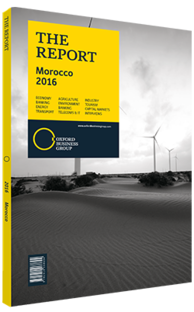Construction
Company Overview
Founded in 1951 and listed on the Casablanca Stock Exchange since 1969, Ciments du Maroc is the second-largest cement player in the country with a 23.8% market share. It produces 3.3m tonnes of cement in a market that consumed 14.2m tonnes in 2015. The group is currently running under capacity at 4.3m tonnes, which is equivalent to a utilisation rate of 78%, in an overall market capacity of 20.3m tonnes. Ciments du Maroc has three cement plants: one in Marrakech (capacity 1.3m tonnes), Safi (0.8m tonnes) and Agadir (2.2m tonnes). Furthermore, the group produces ready-mixed concrete and aggregates, which account for 12% of total revenues. Nonetheless, the margins on these activities are relatively insignificant compared to those on cement. The group plans to invest in a new cement plant in the north of Morocco. However, the management of the company has not published the development timeline of this new plant.
In 2015 the company posted sales of Dh3.73bn (€342m), up 8.5% year-on-year, mainly driven by a 1.2% increase in cement volumes (almost in line with the national market growth of 1.4%), along with 38% and 30% volume increases of concrete and aggregates, respectively. Although the company did not provide an indication about its pricing-policy evolution in 2015, we believe its cement selling prices have increased by at least 4%. The company stabilised its market share over 2015 (at 23.8%) but this decreased slightly to 23.5% in the second half of 2015 from 24.1% in the first half of 2015, in a context where the regions the company operates in have largely outperformed the market. Indeed, the South and centre-South registered a cumulative increase in cement consumption of 5.9% in the first half of 2015 and 10.6% in the second half. This leads us to believe that the management of the company chose to protect its margins rather than its market share in a context of increasing competition in the South. Gross profit and earnings before interest and taxes (EBIT) increased by 13.3% and 14.9%, respectively, to Dh1.68bn (€154m) and Dh1.18bn (€108.2m), inducing increases in margins of 1.9 points and 1.8 points as a result of both cement price increase and a decrease in petroleum coke charge (by 10% according to our estimates). Net income was boosted by 34.5% to Dh813m (€74.5m) by a partial provision recovery related to Suez Cement, of which Ciments du Maroc owns around 11%.
Outlook
As a result of the expected 2% growth in national cement consumption and taking into account a stabilisation of the company’s market share at 23.8%, sales should increase by 1.9% to Dh3.8bn (€348.4m) in 2016 as we are also assuming a stabilisation of selling prices.
EBIT should grow by 2.2% to Dh1.2bn (€110m), i.e. a slight increase of EBIT margin to 31.6%. Net profit should stand at Dh957m (€87.7m), down 12.5% compared to 2015, impacted by an unfavourable base effect as 2015 recorded a provision recovery related to Suez Cement participation. We do not believe that the residual provision on the company (Dh193m, €17.7m) can be recovered in the short term.
According to our forecasts, Ciments du Maroc trades currently at enterprise value to earnings before interest, taxes, depreciation and amortisation in 2016 and 2017 of 9.9x and 9.6x, respectively, i.e. with a 35% premium as compared to the average level between 2011 and 2014 (7.4x). Taking into account our target price at Dh1060 (€97.19) compared to the current price at Dh1240 (€113.69), this premium is limited to 15-20%, which might be justified by the higher growth prospects in the south of Morocco where most of the company’s plants are located. We expect a dividend per share of Dh75.70 (€6.94) in 2015 and Dh68.90 (€6.23) the following year (pay-out ratio of 100%), which represents a dividend yield of 6.7% in 2015 and 5.8% in 2016.
You have reached the limit of premium articles you can view for free.
Choose from the options below to purchase print or digital editions of our Reports. You can also purchase a website subscription giving you unlimited access to all of our Reports online for 12 months.
If you have already purchased this Report or have a website subscription, please login to continue.

